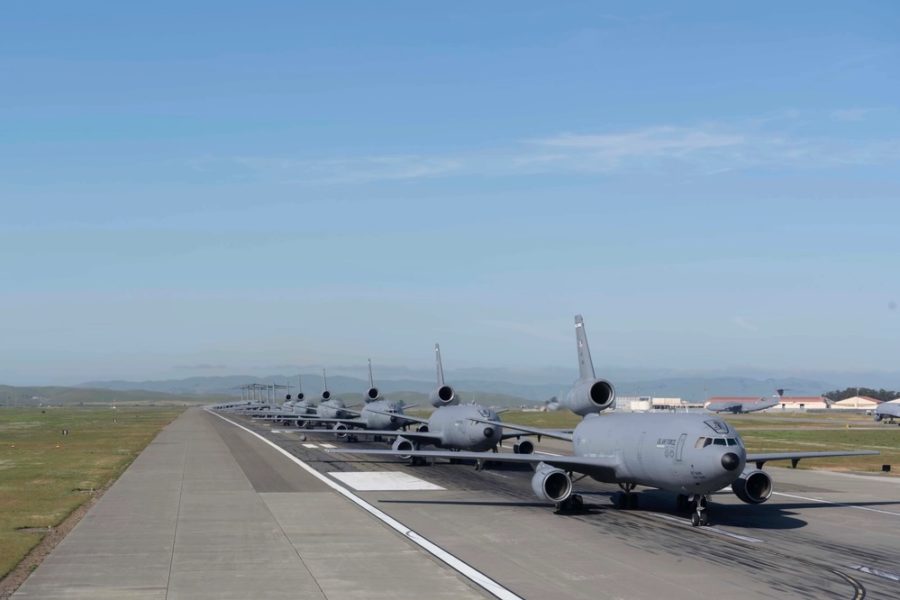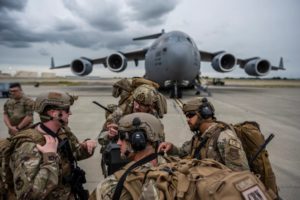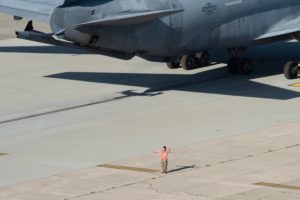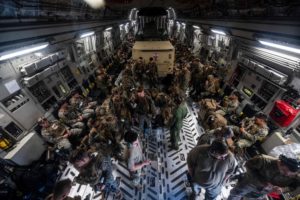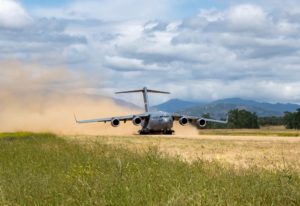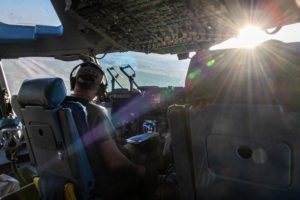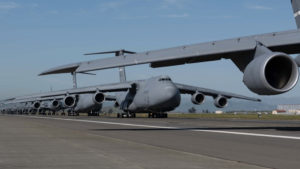A line of 21 C-5s, C-17s, and KC-10s rolled down the runway and into the skies over Travis Air Force Base, Calif. on May 12 in a “maximum aircraft generation event.”
The impressive display of airpower came on the final day of a nearly two-week exercise that saw Airmen, Marines, and Sailors practice moving people and cargo to locations in California and Nevada. Between the exercise and the large takeoff, nearly all of the aircraft at Travis were off the ground May 12, leaving the base, known as the “Gateway to the Pacific,” nearly empty.
“It was interesting to see our ramp pretty bare,” Capt. Ryan Huber, the chief of plans at the 60th Air Mobility Wing, told Air & Space Forces Magazine. Huber and his team had been working since the end of January to put together the exercise, which under other circumstances might take the better part of a year to plan out.
“Caffeine was definitely a big help, a lot of long days,” he said. “But to be a part of the process from the beginning, where this was just an idea, all the way through execution was a pretty cool experience.”
Air Mobility Command, which oversees the tanker and transport jets such as the ones at Travis, is preparing to move troops and supplies over vast distances in a short amount of time should a conflict break out with a near-peer adversary such as China or Russia.
“AMC is the meaningful maneuver. There is too much water and too much distance for anyone else to do it relevantly at pace, at speed, at scale,” AMC boss Gen. Mike Minihan said last year. “Everybody’s role is critical, but Air Mobility Command is the maneuver for the joint force. If we don’t have our act together, nobody wins. Nobody’s lethal. Nobody’s in position.”
The exercise at Travis—which was really three separate but interconnected exercises—aimed to prepare Airmen for exactly that responsibility. Dubbed Exercise Golden Phoenix, it saw transport crews depart Travis and head south to Camp Pendleton, Calif., where they picked up more than 340 Marines and Sailors and their equipment, then distributed them to three smaller locations in California and Nevada as part of the 1 Marine Expeditionary Force’s Readiness Exercise (REDEX).
One of those locations was Fort Hunter-Liggett, situated about halfway between San Francisco and Los Angeles, where Airmen from the 921st Contingency Response Support Squadron (CRSS) and the 621st Contingency Response Wing had arrived earlier to prepare the dirt airstrip for large numbers of aircraft coming through as part of Exercise Storm Crow. Contingency response Airmen specialize in quickly turning austere airfields into thriving airpower hubs, a skill which may come in handy in the Pacific.
“Our largest success was demonstrating the ability to assess, open, and operate airfields in a contested environment with the help of our joint force partners,” Lt. Col. Timothy Kniefel, 921st CRSS commander, said in a press release. “This capability will be absolutely critical to the future fight, and we couldn’t have done it without the Marines, the 60th AMW, and the unwavering dedication of every single multi-capable CR member on the team.”
By ‘multi-capable,’ Knifel was referring to the Air Force concept of Airmen picking up skills outside of their usual job specialty, which could help the service set up operations without as many people or supplies. During the exercise, Huber said he saw civil engineering Airmen pull security, cyber communication Airmen help fix HVAC systems, and non-cargo-moving Airmen help transport supplies around the airfield. It was rewarding to see people step out of their normal job description and work together to accomplish the mission, he said.
After the contingency response Airmen set up initial operations at the dispersed airfields, Airmen from the 60th Air Mobility Wing moved in to practice taking over the long-term operation.
“The expeditionary air base was tasked with taking over the base from contingency response (CR) forces in order to allow them to project the cluster farther forward,” Maj. Cal San Filippo, the expeditionary air base detachment commander, said in the press release. “We immediately integrated into the CR’s operating schedule and began manning shifts. The team wasted no time.”
Meanwhile, Airmen with the 60th Medical Group and the 60th Aeromedical Evacuation Squadron practiced transporting simulated casualties from deployed locations, and Airmen from the 60th Maintenance Group (MXG) made sure the aircraft could sustain moving 1.53 million pounds of cargo and more than 700 passengers over 12 days.
“They’ve been working 24 hours around the clock to produce the airlift needed for this exercise,” Lt. Col. Tom Reynolds, 60th MXG deputy commander, said in the press release. “They’ve done an incredible job and we’re incredibly proud.”
The final day was the maximum generation event, where 21 aircraft took off in rapid succession—a helpful tactic if an airfield must be evacuated quickly. It was the second-largest launch in Travis history, with the largest involving 22 aircraft in 2013.
As big and complicated as Exercise Golden Phoenix was, there will be an even larger Air Mobility Command training operation later this summer. Operation Mobility Guardian will take place over an area of more than 3,000 miles under U.S. Indo-Pacific Command’s jurisdiction and will involve at least 7 countries plus nearly every branch of the U.S. military. Minihan said in March the exercise will be a chance for his troops to “understand intimately what the tyranny of distance is and what the tyranny of water is.”
Part of the idea behind Exercise Golden Phoenix was to help prepare the 60th Air Mobility Wing for Mobility Guardian, Huber said.
“The whole machine is working that power projection: being able to move out our partners to go do their missions,” Huber explained.
